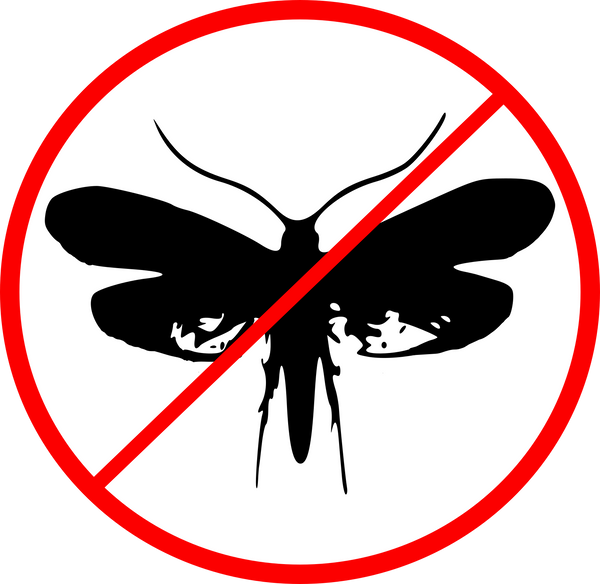Dealing with Clothing Moths
Posted on May 09 2018

Part 1: Identifying the Evil Little Clothing Moth
(Important note: there is no such thing as a Good Little Clothing Moth)
These little buggers are the bane of folks who enjoy natural fibers. Lovers of dark places, (like your storage closet or the center of your ball of yarn) clothing moths will stealthily lay eggs in your favorite clothes and yarn. When the eggs hatch, the larvae make a tidy little feast of your natural fibers, turn into more clothing moths… and so the cycle continues.
While they prefer wool, they will also happily munch on cotton, linen, cashmere, alpaca, llama, yak, mohair, and silk. Almost any natural fiber will do for a hungry little clothes moth larva. The eggs are wee, tiny little things that are just visible to the naked eye. The easiest way to identify an infestation of clothing moths is to look for the larva casings or webs (along with holes in your clothes and broken strands of yarn). The casings or webs will often take the color of the fabric being eaten, so keep an eagle eye out for them.
You can also buy clothing moth traps (the ones with the pheromones are best), but be aware that this is just an early warning system, since it will only catch the males. The females, of course, lay the eggs, which turn into larvae, which eat your fibers, which turn into more moths… you get the idea.
Part 2: Killing the Evil Little Clothing Moth and Getting Rid of Infestations
While moth balls (aka paradichlorobenzene or naphthalene) and other insecticides will certainly kill moth larvae, they can also be toxic to us and our pets if not safely handled. Plus they leave a yucky smell. Also on the chemical side of things, if an infestation has affected your clothing you can bring your clothing to a dry cleaners; the dry cleaning chemicals will successfully kill clothing moths. However, if you are looking for a chemical-free way to kill clothing moths, the best way to deal with them is by cooking or freezing the larvae and eggs.
To kill clothing moth larvae and eggs by heat, place the items in an oven or food dryer at a temperature higher than 120° F (50° C) for at least 30 minutes. Simple. This is probably the easiest way to deal with clothing moth larvae and eggs.
Killing clothing moths by freezing is easy too, and just a smidge more involved. To kill clothing moths by freezing them, the items must 1) first be at least 70° F (21° C), and then 2) placed in a freezer set to below 18° F (-8° C) for at least 72 hours. It is the abrupt cold followed by freezing that kills the larvae, rather than just the freezing, so step one is important. Freezing may not kill all the eggs, though, so after you have frozen your items once, put them in a plastic bag for several days so any surviving eggs have a chance to develop, and them repeat the freezing process as described one more time. That should do the trick.
Fumigation with dry ice also works nicely. Get a 30-gallon plastic bag and about a pound of dry ice. Put the dry ice in the bottom of the bag, followed by your clothes and/or yarn, and tie the bag loosely (at first). Tying the bag loosely while the dry ice sublimates will prevent balloon-type explosions. When the dry ice is close to gone, tie the bag tightly and set it aside for 72 hours. This will kill all stages of clothes moths.
Do you have clothing moth problem that seems to have taken over your entire house, rather than just a few items? Well, there are a few options. You can treat your clothing and yarn as above, and then do a top to bottom house cleaning, making sure to vacuum every few days over the course of a couple weeks (make sure to get the edges and corners). Set out new clothing moth pheromone traps every few days to monitor the infestation, and check them frequently. If the traps aren’t catching any moths after a couple of weeks, you are good to go. Alternatively, you can bring in a pest control company – while we at Northwest Yarns aren’t huge fans of treating our homes with bug killing chemicals, it will certainly get the job done if all else has failed.
What about natural herbs and oils? Well, unfortunately, those won’t kill clothing moths, although they can be used to irritate and discourage them. Which brings us to…
Part 3: Discouraging and Annoying Evil Little Clothing Moths
Hands down, the absolute best way to keep clothing moths away from fiber munchies is to seal your natural fibers in an airtight container of some sort, which is how we store our backstock at the shop. Resealable zip bags, airtight boxes, vacuum sealed bags – these will all work nicely to store yarn and clothing that isn’t being immediately used. When we say airtight, though, we mean absolutely airtight. You wouldn’t believe how tiny a space female clothing moths can slip through.
That said, we know that keeping all of your natural fiber and clothing locked up tight isn’t always practical. You have blankets on your bed, sweaters in your closet, those half dozen projects sitting around that you are definitely going to work on this week… so what to do? Sorry to say that the only other 100% effective method of repelling moths aside from sealing your fiber in airtight containers is to use moth balls, which ( as previously noted) can be toxic to people and pets. Plus they smell terrible. So, we really don’t recommend moth balls. Fortunately, there are some ways to discourage and irritate clothing moths so your chances of an infestation are greatly reduced.
Keep your finished natural fiber projects clean. However, please note that having a clothing moth infestation does not mean you or your house are dirty! Seriously, no judgement here. It is just that while clothing moths will happily lay eggs in clean fiber, dirt will make your yarn and clothing extra delicious and increase the chances of an infestation – those extra vitamins and minerals are good for growing larvae and, like all mothers, mama moths want the best possible environment for their offspring. And dirt can mean anything from actual, outdoors dirt to that tiny little bit of sunscreen you got on the collar of your cardigan last week. Or, if you are me, that ice cream smudge that you quickly rubbed away so nobody could detect what an uncoordinated eater you are.
So, your fiber is clean as clean can be? Well, you can still get clothing moths. It is unfair, we know. Fortunately, there are some safer methods than moth balls to discourage moths – many people have chosen to use plant based repellents. Clothing moths find eucalyptol (aka 1, 8 ceneole) and camphor, substances naturally occurring in some plants, to be particularly irritating and inhospitable. These are found in sufficient concentration in the Eastern Red Cedar (Juniperus virginiana – actually a type of juniper rather than a cedar tree) and in lavender (Lavandula angustifolia), as well as in several other plants. The dried plants themselves aren’t necessarily enough, though, since the oils that repel moths can diffuse over a period of time. This means that simply placing sachets of lavender flowers or Eastern Red Cedar among your clothing and then forgetting about them won’t quite do the trick. You must also place several drops of these plants’ essential oils on the sachets or wood, and then be sure to refresh each month with additional essential oil for optimal clothing moth repelling. Here at Northwest Yarns, we like using lavender for this purpose – a quick jaunt around the store will reveal strategically placed lavender sachets all around the shop, plus we use lavender oil in an essential oil diffuser.
Remember, we here at Northwest Yarns are ever vigilant against clothing moths! If you are bringing in outside fiber to match or work with at our shop, please make sure to bring it in a plastic bag and let us eyeball it for clothing moths. We do all we can to prevent them and now you can, too!

Follow US